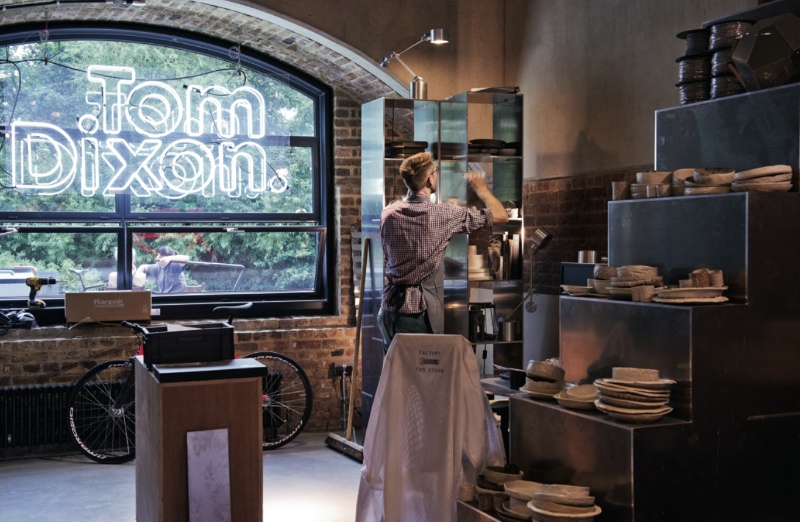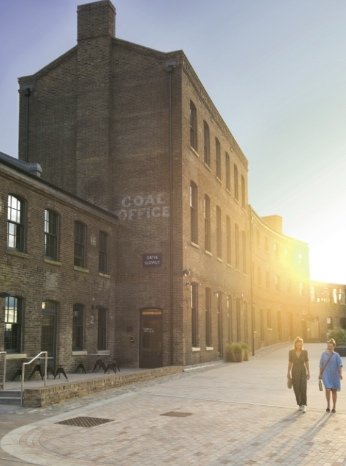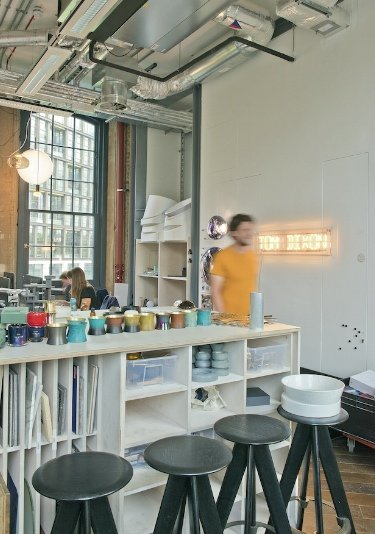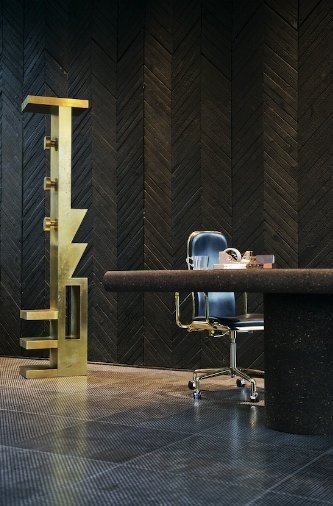Office Space: In the first of our new series exploring London’s most stunning HQs, we explore designer Tom Dixon’s new offices in King’s Cross

For some companies, an office is simply a place for their employees to sit, or a meeting space for clients. For Tom Dixon, it’s a showroom, a business hub, a hip hangout, a restaurant, an arts and crafts school and a community outreach facility. There are also employees, of course, sitting behind desks and computers, but that’s the least interesting part.
The London-born but now global interior design studio switched its canal-side office at Portobello Dock in Ladbroke Grove for a canal-side office at Coal Drop’s Yard in King’s Cross. The new retail destination officially opens next month as part of the extensive regeneration of the area that will see Samsung, Google and Facebook join Central St Martin’s College of Art and Design in N1.
“For us, it was imperative not just to find a new office or shop. It was vital to find a new home. London isn’t just another city. It is where it all started,” Tom Dixon said when the move was announced a year ago.
Dixon likes to do most of his meetings over coffee, lunch or dinner, so having a happening dining spot in his HQ simply saves time
The building he chose is a 17,500sqft heritage gem. Constructed in 1851, The Coal Office is a perfectly preserved piece of Victorian industrial architecture that follows the curve of the Regent’s Canal. From here, merchants would trade coal and fish and load up barges with goods. During the 1990s, it was a club, providing the backdrop to many hazy garage nights.
“We get a lot of people come into the shop and say ‘Whoa, I used to come here all the time’!” says Ian Slover, studio managing director, who worked as a design consultant in London and New York before joining Tom Dixon.
Needless to say, he’s very much looking forward to the increased footfall to Coal Drop’s Yard when it opens on 26 October. For now, they have to rely on a canalside placard and directions painted on the windows in Tipp-Ex to get the punters in. Dixon did them himself, apparently, including the ‘Tom Dixon OFFICE’ legend scrawled onto the front door.

The Coal Office in King's Cross. Photo: Greg Sigston
Once inside, Dixon’s signature hexagonal light installations hang from the high ceilings so typical of these now-trendy warehouses. Where possible, furniture from the Dixon range is used. In fact, everything in the presentation room adjacent to the reception is Dixon’s apart from the coffee machine and taps.
The ground floor is the public-facing part of the operation, inviting people in with aromas of coffee – and curry, on the day I visited. The Coal Office is also the name of the restaurant that opened this month on the ground floor, the latest venture from Asaf Granit, the chef behind the wildy popular Palomar and The Barbary. In keeping with the ethos of openness, high energy tunes pump through the space while chefs prep in an open kitchen.
There’s also a bar, a pizza oven, bakery and two private dining rooms spread over three floors and a rooftop terace with panoramic views over the new retail quarter. Dixon likes to do most of his meetings over coffee, lunch or dinner, so having a happening dining spot in his HQ simply saves time. The last office had one, too.
“The restaurant has some chairs that haven’t launched yet from a new line out next year,” says Slover. “Tom really likes to test things so the restaurant, for us, is a place to try things out.”

Studio workspace at the Coal Office. Photo: Greg Sigston
Marble slabs, off-cuts from Italy, form jagged countertops while brick, steel and ash-coloured surfaces dominate (inspired by a fire on the site in the 1970s), which fits perfectly with Dixon’s ‘rough around the edges’ aesthetic.
Dogs are encouraged – one eyes up a sheepskin-covered armchair – and the finance department have an ice-cream rota on the whiteboard
Many of the architectural features weren’t actually chosen by Dixon but by Jamie Oliver, who was going to take the spot before Dixon signed up. DRS Architects and David Morley Architects restored the rest, with Dixon handling interiors himself.
Stomp up the concrete steps, and a series of design studios lay themselves out, with hot-desking stations on the upper floors, organised by department. Most staffers arrive at 9am and leave by 6pm, though “Tom is the first one to arrive and the last to leave,” says Slover.

The reception at the Coal Office. Photo: Greg Sigston
Dogs are encouraged – one eyes up a sheepskin-covered armchair – and the finance department have an ice-cream rota on the whiteboard (no brands are off-limits, but everyone has to take it in turns to buy tubs for the team). Fortnightly ‘town hall’ meetings take place in one of two large meeting rooms, but departments swap ideas on Facebook-owned digital platform Workplace the rest of the time.
Professionals weave their way around paintings and inspirational tidbits stacked haphazardly against walls. “The funny thing is, Tom would find all these paintings in boot sales, just things he liked, so we were using them in the retail spaces and people were, like, buying them. So now Tom’s constantly having to find more paintings for the shops,” says Slover.
Another pet passion of Dixon’s can be found in a dark corner in the basement where a single workbench is surrounded by off-cuts and works in progress. “Tom’s a bit disillusioned because it’s really hard to make things in central London now because of the cost. All of our manufacturing has ended up in Eastern Europe and India, but Tom has this dream of making things in central London again. He wanted this workshop to be much bigger, but we ended up doing The Factory instead.”
That community project lives on the ground floor in the heart of the retail space. ‘Partners’ – craftsman and small businesses that Dixon wants to collaborate with – and students from nearby Central St Martin’s College run workshops sharing their skills. Two students were teaching ceramics underneath the Listed brick arches and a pickle jar tutorial is next on the schedule. Many of the efforts end up back in the restaurant.
The other arches are divided into furniture, textiles, lighting, accessories and a scent shop. In the corner, a storage space is being transformed into a kitsch disco for the London Design Festival.
If Tom Dixon’s head office proves anything, it’s that a workplace can be almost anything you need it to be.